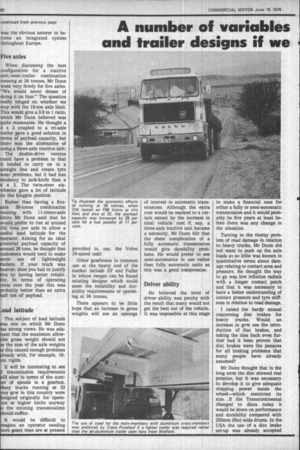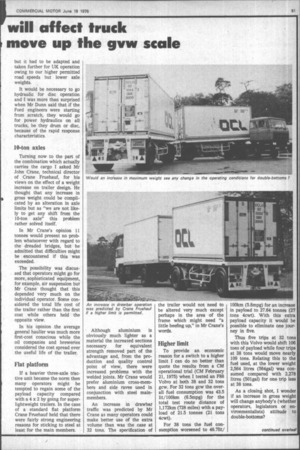A number of variables
Page 82

Page 83

If you've noticed an error in this article please click here to report it so we can fix it.
and trailer designs if we will affect truck move up the gvw scale
was the obvious answer to became an integrated system throughout Europe.
Five axles
When discussing the best configuration for a tractive unit/semi-trailer combination running at 38 tonnes, Mr Dunn went very firmly for five axles. "We would never dream of doing it on four." The question really hinged on whether we stay with the 10-ton axle limit. This would give a 3.8 to 1 ratio, which Mr Dunn believed was quite reasonable. He thought a 4 x 2 coupled to a tri-axle trailer gave a good solution in terms of payload capacity, but there was the alternative of using a three-axle tractive unit.
The double-drive version could have a problem in that it tended to carry on in a straight line and create tyre wear problems, but it had less tendency to jack-knife than a 4 x 2. The twin-steer sixwheeler gave a lot of latitude on the kingpin position.
Rather than having a five axle 38-tonne combination running with 11-tonne-axle limits Mr Dunn said that he would prefer to run at around :10i tons per axle to allow a seful load latitude for the perator. Aiming for an ideal otential payload capacity of round 26 tons, he thought that ustomers would tend to make ore use of lightweight milers. If your truck was eavier, then you had to justify his by having better reliabi ity. In terms of operating osts over the year this was robably better than an extra alf ton of payload.
ad latitude
This subject of load latitude as one on which Mr Dunn as strong views. He was adaant that the maximum allowble gross weight should not e the sum of the axle weights s this caused enough problems lready with, for example, 16on rigids.
It will be interesting to see f transmission requirements ill alter in terms of the numer of speeds in a gearbox. any trucks running at 32 ons gcw in this country were esigned originally for operaion at higher limits anyway o the existing transmissions hould suffice.
It would be difficult to magine an operator needing ore gears than are at present provided in, say, the Volvo 16-speed unit!
Other gearboxes in common use at •the heavy end of the market include ZF and Fuller in whose ranges can be found existing designs which could meet the reliability and durability requirements of operating at 38 tonnes.
There appears to be little hope that an increase in gross weights will see an upsurge of interest in automatic transmissions. Although the extra cost would be masked to a certain extent by the increase in total vehicle cost if, say, a three-axle tractive unit became a necessity, Mr Dunn felt that the sheer complication of a fully automatic transmission would give durability problems. He would prefer to see semi-automatics in use rather than fully automatic units as this was a good compromise.
Driver ability
He believed the level of driver ability was patchy with the result that many would not get the best out of the vehicle. It was impossible at this stage to make a financial case for either a fully or semi-automatic transmission and it would probably be five years at least before there was any change in the situation.
Turning to the thorny problem of road damage in relation to heavy trucks, Mr Dunn did not want to push up the axle loads as so little was known in quantitative terms about damage relating to contact area and pressure. He thought the way to go was low inflation radials with a longer contact patch and that it was necessary to have a better understanding of contact pressure and tyre stiffness in relation to road damage.
I raised the hardy annual concerning disc brakes for heavy trucks. Would an increase in gvw see the introduction of disc brakes, and taking the idea back even further had it been proven that disc brakes were the panacea for all braking problems that many people have already assumed?
Mr Dunn thought that in the long term the disc showed real promise, but it was necessary to develop it to give adequate stopping power inside the wheel—which restricted its size. If the Transcontinental changed to discs today it would be down on performance and durability compared with 203mm (8in) wide drums. In the USA the use of a disc brake set-up was already accepted but it had to be adapted and taken further for UK operation owing to our higher permitted road speeds but lower axle weights.
It would be necessary to go hydraulic for disc operation and I was more than surprised when Mr Dunn said that if the Ford engineers were starting from scratch, they would go for power hydraulics on all trucks, be they drum or disc, because of the rapid response characteristics.
10-ton axles
Turning now to the part of the combination which actually carries the cargo I asked Mr John Crane, technical director of Crane Fruehauf, for his views on the effect of a weight increase on trailer design. He thought that any increase in gross weight could be complicated by an alteration in axle limits but as "we are not likely to get any shift from the 10-ton axle" this problem rather solved itself.
In Mr Crane's opinion 11 tonnes would present no problem whatsoever with regard to the dreaded bridges, but he admitted that difficulties might be encountered if this was exceeded.
The possibility was discussed that operators might go for more, sophisticated equipment, for example, air suspension but Mr Crane thought that this depended very much on the individual operator. Some considered the total life cost of the trailer rather than the first cost while others held the Opposite view.
In his opinion the average general haulier was much more first-cost conscious while the oil companies and breweries considered the cost spread over the useful life of the trailer.
Flat platform
If a heavier three-axle tractive unit became the norm then many operators might be tempted to regain some of the payload capacity compared with a 4 x 2 by going for superlightweight trailers. In the case of a standard flat platform Crane Fruehauf held that there were fairly strong engineering reasons for sticking to steel at least for the main members.
An increase in drawbar operation was predicted by Crane Fruehauf if a higher limit is permitted.
Although aluminium is obviously much lighter as a material the increased sections necessary for equivalent strength removed part of the advantage and, from the production and quality control point of view, there were increased problems with the welded joints. Mr Crane would prefer aluminium cross-members and side raves used in conjunction with steel mainmembers.
An increase in drawbar traffic was predicted by Mr Crane as many operators could make better use of the extra volume than was the case at 32 tons. The specification of the trailer would not need to be altered very much except perhaps in the area of the frame which might need "a little beefing up," in Mr Crane's words.
Higher limit
To provide an economic reason for a switch to a higher limit I can do no better than quote the results from a CM operational trial (CM February 21, 1975) when I tested an F88 Volvo at both 38 and 32 tons gcw. For 32 tons gcw the overall fuel consumption was 43.5 lit/100km (6.5mpg) for the total test route distance of 1,172km (728 miles) with a payload of 21.5 tonnes (21 tons 4cwt).
For 38 tons the fuel consumption worsened to 48.71it/ 100km (5.8mpg) for an increase in payload to 27.64 tonnes (27 tons 4cwt). With this extra payload capacity it would be possible to eliminate one journey in five.
Thus five trips at 32 tons with this Volvo would shift 146 tons of payload while four trips at 38 tons would move nearly 109 tons. Relating this to the fuel used, at the lower weight 2,564 litres (564ga1) was consumed compared with 2,278 litres (501gal) for one trip less at 38 tons.
As a closing shot, I wonder if an increase in gross weight will change anybody's (whether operators, legislators or environmentalists) attitude to double-bottoms?












































































































































































